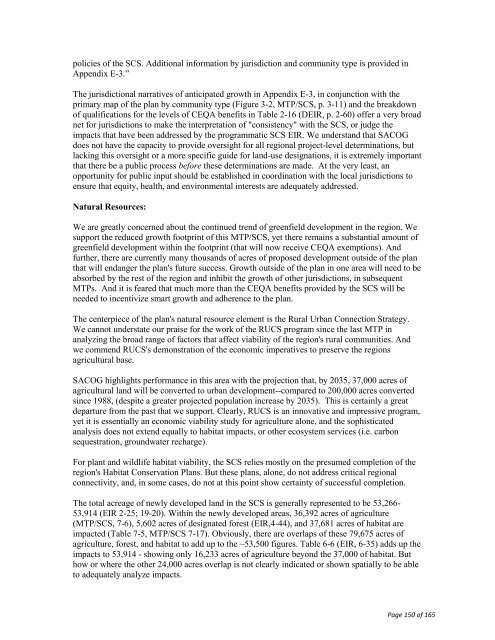Draft MTP/SCS Comments Received - sacog
Draft MTP/SCS Comments Received - sacog
Draft MTP/SCS Comments Received - sacog
Create successful ePaper yourself
Turn your PDF publications into a flip-book with our unique Google optimized e-Paper software.
policies of the <strong>SCS</strong>. Additional information by jurisdiction and community type is provided in<br />
Appendix E-3.”<br />
The jurisdictional narratives of anticipated growth in Appendix E-3, in conjunction with the<br />
primary map of the plan by community type (Figure 3-2, <strong>MTP</strong>/<strong>SCS</strong>, p. 3-11) and the breakdown<br />
of qualifications for the levels of CEQA benefits in Table 2-16 (DEIR, p. 2-60) offer a very broad<br />
net for jurisdictions to make the interpretation of "consistency" with the <strong>SCS</strong>, or judge the<br />
impacts that have been addressed by the programmatic <strong>SCS</strong> EIR. We understand that SACOG<br />
does not have the capacity to provide oversight for all regional project-level determinations, but<br />
lacking this oversight or a more specific guide for land-use designations, it is extremely important<br />
that there be a public process before these determinations are made. At the very least, an<br />
opportunity for public input should be established in coordination with the local jurisdictions to<br />
ensure that equity, health, and environmental interests are adequately addressed.<br />
Natural Resources:<br />
We are greatly concerned about the continued trend of greenfield development in the region. We<br />
support the reduced growth footprint of this <strong>MTP</strong>/<strong>SCS</strong>, yet there remains a substantial amount of<br />
greenfield development within the footprint (that will now receive CEQA exemptions). And<br />
further, there are currently many thousands of acres of proposed development outside of the plan<br />
that will endanger the plan's future success. Growth outside of the plan in one area will need to be<br />
absorbed by the rest of the region and inhibit the growth of other jurisdictions, in subsequent<br />
<strong>MTP</strong>s. And it is feared that much more than the CEQA benefits provided by the <strong>SCS</strong> will be<br />
needed to incentivize smart growth and adherence to the plan.<br />
The centerpiece of the plan's natural resource element is the Rural Urban Connection Strategy.<br />
We cannot understate our praise for the work of the RUCS program since the last <strong>MTP</strong> in<br />
analyzing the broad range of factors that affect viability of the region's rural communities. And<br />
we commend RUCS's demonstration of the economic imperatives to preserve the regions<br />
agricultural base.<br />
SACOG highlights performance in this area with the projection that, by 2035, 37,000 acres of<br />
agricultural land will be converted to urban development--compared to 200,000 acres converted<br />
since 1988, (despite a greater projected population increase by 2035). This is certainly a great<br />
departure from the past that we support. Clearly, RUCS is an innovative and impressive program,<br />
yet it is essentially an economic viability study for agriculture alone, and the sophisticated<br />
analysis does not extend equally to habitat impacts, or other ecosystem services (i.e. carbon<br />
sequestration, groundwater recharge).<br />
For plant and wildlife habitat viability, the <strong>SCS</strong> relies mostly on the presumed completion of the<br />
region's Habitat Conservation Plans. But these plans, alone, do not address critical regional<br />
connectivity, and, in some cases, do not at this point show certainty of successful completion.<br />
The total acreage of newly developed land in the <strong>SCS</strong> is generally represented to be 53,266-<br />
53,914 (EIR 2-25; 19-20). Within the newly developed areas, 36,392 acres of agriculture<br />
(<strong>MTP</strong>/<strong>SCS</strong>, 7-6), 5,602 acres of designated forest (EIR,4-44), and 37,681 acres of habitat are<br />
impacted (Table 7-5, <strong>MTP</strong>/<strong>SCS</strong> 7-17). Obviously, there are overlaps of these 79,675 acres of<br />
agriculture, forest, and habitat to add up to the ~53,500 figures. Table 6-6 (EIR, 6-35) adds up the<br />
impacts to 53,914 - showing only 16,233 acres of agriculture beyond the 37,000 of habitat. But<br />
how or where the other 24,000 acres overlap is not clearly indicated or shown spatially to be able<br />
to adequately analyze impacts.<br />
Page 150 of 165
















